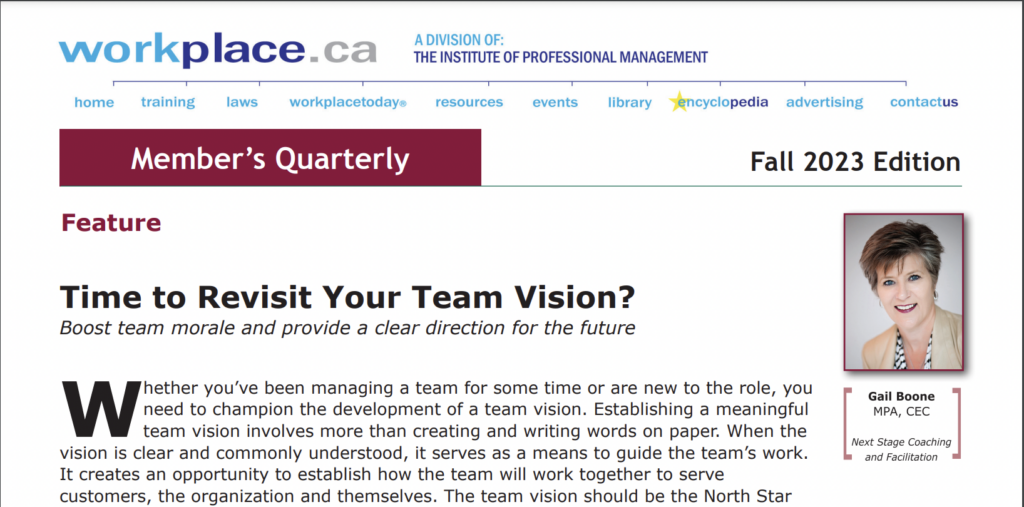Time to Revisit Your Team Vision?

THIS POST WAS ORIGINALLY SHARED ON Workplace.ca
Whether you’ve been managing a team for some time or are new to the role, you need to champion the development of a team vision. Establishing a meaningful team vision involves more than creating and writing words on paper. When the vision is clear and commonly understood, it serves as a means to guide the team’s work.
It creates an opportunity to establish how the team will work together to serve customers, the organization and themselves. The team vision should be the North Star and serve as the guidepost for everything the team does. The team vision is more than a single statement.
It is a narrative description of the desired future state. It is aspirational, something the team values and is dedicated to putting effort in to achieve. Once the team vision is finalized, a plan to help the team move from the current to the future state is critical.
There are several principles to practice and steps to follow when establishing the vision.
Ensure everyone has an opportunity to be involved.
People help to implement what they create. From the beginning of this process, map a strategy to ensure
that all team members can participate. Consider the different ways people like to be involved and plan for
various ways to get input.
Communicate the plan to arrive at the vision statement.
Help people know that describing a meaningful team vision everyone can support and live by takes time.
People can be expected to do individual and group work to discover what is really important for the team.
Start with ensuring the team understands the organization’s mission, vision and mandate.
Team members must be able to describe in their own words what the organization stands for and wants to deliver. This understanding will help to contribute to creating their own team vision.
Host a conversation about the organization’s values.
All too often, employees know their organization’s values by the words they see printed on a brochure or
wall plaque. Ask questions to determine if staff can identify the behaviour implied by the stated values.
How do they feel about those values? How easy is it to live those values?
Identify the team’s values.
Help the team identify, define and understand their values. Take time to move through this process.
Start by talking about the different types of values. For example, Patrick Lencioni’s book The Advantage identifies Core Values, Permission-To-Play Values, Accidental Values and Aspirational Values. A way to explore values might be to describe scenarios and ask staff how they would behave if faced with the situation. Create a long list at first. As people have a chance to define, discuss and demonstrate behaviour, shorten the list to the most important. Ideally the list will be fewer than 10. Make sure to have a complete and agreed description of the value in action. Have people complete a statement such as: “If we are living our values, you should see, experience, feel….”
Ask crucial questions and write the answers as aspirational statements.
Ideally the vision statement will address several elements. Example: “How does the organization view us?” “We are seen as the go-to team.” Other questions might include: What do our customers say about us? What are we known for? How do we support each other? How do the technology and other supports available to us enable our work? What do we say about one another? How do we feel about our team? How do we hold one another accountable? Explore all facets of the work and relationships with others to create a complete and compelling vision.
Draft the first version and solicit the whole team’s feedback.
What feels right about the statement? Can individuals get behind what’s written? How much of a stretch is it between the current and desired reality?
Finalize and post in a prominent area.
Once the work is done, ask each member to sign a copy. Create a wall chart and post it in an obvious spot for all to see. The power of this as a motivational tool cannot be understated. It also serves as a guide to enable productive conversations when things go awry.
Construct and action a team development plan.
Listen throughout the process for areas where team members feel additional professional development is necessary. Work with them to develop a plan that addresses deficits in knowledge, skill or ability. When you invest in the team, everyone wins.
The end goal is a team that wants to work together, can produce results and serves as a magnet for others who wish to join. Motivation and engagement move positively when the way forward is clear and aligned. Everyone benefits.
Gail Boone is an Executive Coach and Owner of Next Stage Coaching & Facilitation and can be reached via email at gailboone@ns.sympatico.ca.
